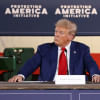Donald Trump may dent but not dethrone King Dollar

Donald Trump says he wants to reverse the strong dollar policy which has underpinned the US economic framework since the early 1990s. "We have a big currency problem," the former president said in an interview with Bloomberg published last week.
His choice for vice president, JD Vance, goes even further. The senator from Ohio wants rid of the dollar's role as de facto global currency as well. "The strong dollar is sort of the sacred cow of the Washington consensus," he explained in 2023, "but when I survey the American economy, and I see our mass consumption of mostly useless imports on the one hand and our hollowed-out industrial base on the other hand, I wonder if the reserve currency status also has some downsides."
Conventional wisdom holds that a second Trump administration would struggle to make good on either mission. That view is correct when it comes to the greenback's global reserve status, but more questionable when it comes to a weaker exchange rate.
A diminished global role for the US dollar is not completely implausible. Indeed, several recent developments have made that momentous shift likelier than in previous decades.
The first is that Uncle Sam has aggressively wielded his currency as a weapon against geopolitical rivals, most prominently freezing Russia's dollar reserves following the invasion of Ukraine in 2022. That has prompted central banks to diversify their holdings, shrinking the US dollar's share of global foreign exchange reserves to 59 percent, from 73 percent in 2001.
Meanwhile, international bodies have stepped up their attempts to develop viable alternatives to the dollar-based payment system on which global trade depends. The Bank for International Settlements is currently piloting one such system, Project Agorá, to link up seven payments systems operated by members of the Organisation for Economic Co-operation and Development. Another, mBridge, aims to provide seamless settlement using central bank digital currencies including the Chinese renminbi.
A third reason to take the prospect of global monetary regime change seriously is that the current system is quite new. It was only in 2022 that financial regulators completed the migration of global credit from a model based on unsecured lending and priced off the London Interbank Offered Rate (LIBOR) to one based on secured lending and the new Secured Overnight Financing Rate (SOFR). One consequence is that global finance is now more tightly coupled to the supply of high-quality US dollar collateral. This new regime has yet to be tested in a crisis.
Ultimately, however, King Dollar remains unique in too many important respects. US financial markets are by far the largest and most liquid in the world. An overwhelming proportion of international trade invoices are in dollars. Most importantly, the Federal Reserve is willing and able to backstop global dollar-denominated finance, as it showed most recently when the pandemic roiled markets in 2020. Even Vice President Vance would struggle to shake the dollar's status as the preferred haven in a financial storm.
The buck's value relative to other currencies, however, is a different matter. There is no doubt that the US dollar is indeed historically strong. In real, trade-weighted terms, it has appreciated more than 30 percent in the last decade and is close to its richest in 40 years, the BIS calculates.
On the face of it, Trump's mooted policies would do little to reverse this trend. Start with trade. The former reality TV host has talked of imposing a 10 percent tariff on all imports, rising to 50 percent or 60 percent for products from China. If implemented, that would probably strengthen the dollar as higher import prices staunch demand for overseas goods and services and hence for the currency needed to purchase them. It is also likely to stoke inflation, prompting the Fed to keep interest rates high and thus attracting more capital inflows.
Trump's future fiscal plans could make things even worse. The former president has pledged to renew the tax cuts introduced during his first term and to reduce corporation tax. Such largesse would goose demand, leading to tighter monetary policy still – and thus an even stronger dollar.
These contradictions are why Trump supporters are discussing less conventional countervailing strategies. The former real estate developer has suggested imposing capital controls to stem demand from overseas investors for American assets, and the dollars needed to buy them. The Republican Party's 2024 Platform even appears to suggest an outright ban on Chinese acquisitions of direct equity investments or real estate.
Trump allies have discussed hobbling the Fed's independence to rein in interest rates, the Wall Street Journal reported in April, citing people familiar with the matter, though the campaign played down the story. Fed Chair Jerome Powell's term comes up for renewal in 2026: a replacement might be more amenable to lower interest rates. Another option would be to broker an international monetary agreement to weaken the US dollar modelled on the 1985 Plaza Accord, which depreciated the currency against the yen and Deutsche mark. The theory is that the threat of tariffs might bring China and Japan to the table.
Such heterodox measures are risky. Conventional wisdom holds that the benefits of a weaker dollar are historically not broad enough to win sufficient support. While parts of the domestic economy would stand to gain from a cheaper greenback, the financial sector likes sound money. It is also unclear why Asian creditor nations would agree to help their biggest debtor devalue.
Yet much of this history is out of date. Under the new regime of secured finance, for example, the global credit system depends on the US running fiscal deficits to provide an adequate supply of collateral to borrowers. That makes easy money a requirement for robust credit growth and means the interests of Main Street and Wall Street are more aligned. America's allies in the emerging world, meanwhile, are generally US dollar debtors who would benefit from a weaker greenback. In the shorter term, slowing growth will enable the Fed to lower rates anyway, easing the upward pressure on the US currency.
These new realities mean that efforts to weaken the dollar may soon be pushing at an open door. While the greenback's role as the global currency is here to stay, the days of dollar strength are numbered – regardless of who wins the presidential election in November.

 For all latest news, follow The Daily Star's Google News channel.
For all latest news, follow The Daily Star's Google News channel. 








Comments